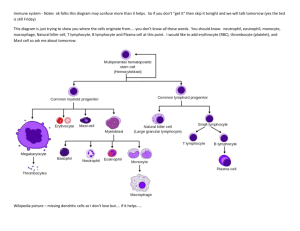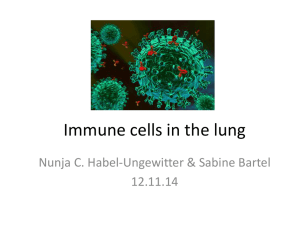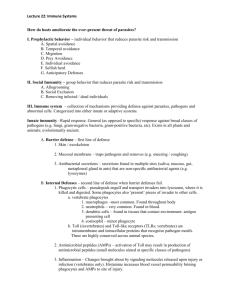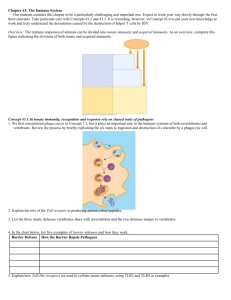Dendrites Stimulus Nucleus Cell body Axon hillock Presynaptic cell
advertisement
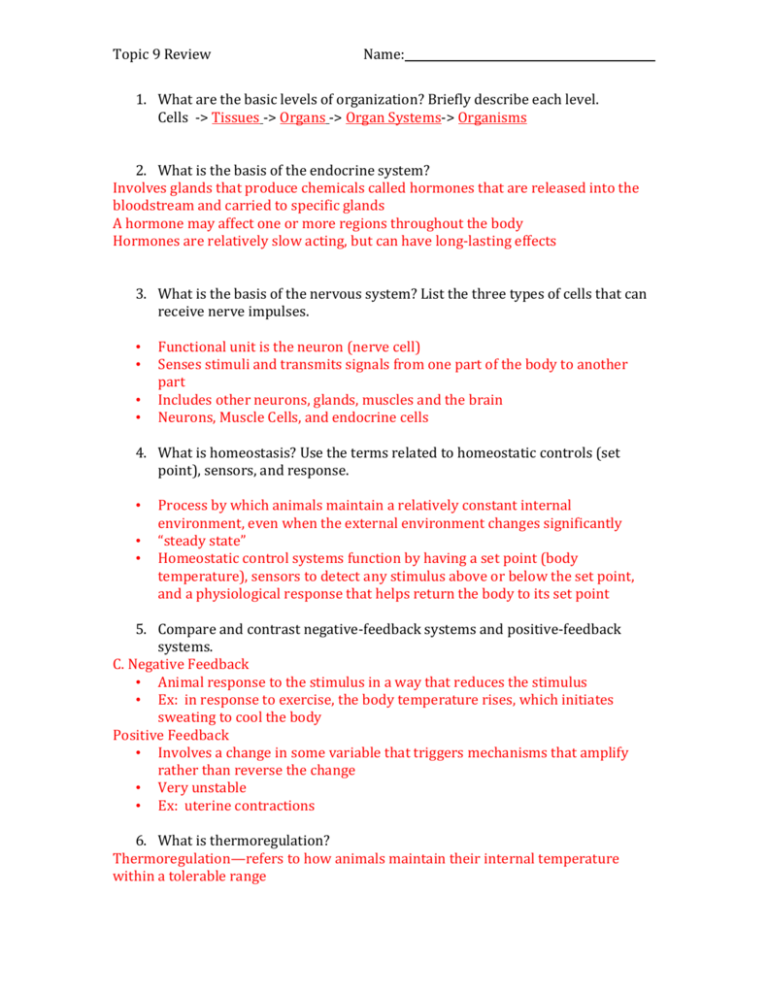
Topic 9 Review Name: 1. What are the basic levels of organization? Briefly describe each level. Cells -> Tissues -> Organs -> Organ Systems-> Organisms 2. What is the basis of the endocrine system? Involves glands that produce chemicals called hormones that are released into the bloodstream and carried to specific glands A hormone may affect one or more regions throughout the body Hormones are relatively slow acting, but can have long-lasting effects 3. What is the basis of the nervous system? List the three types of cells that can receive nerve impulses. • • • • Functional unit is the neuron (nerve cell) Senses stimuli and transmits signals from one part of the body to another part Includes other neurons, glands, muscles and the brain Neurons, Muscle Cells, and endocrine cells 4. What is homeostasis? Use the terms related to homeostatic controls (set point), sensors, and response. • • • Process by which animals maintain a relatively constant internal environment, even when the external environment changes significantly “steady state” Homeostatic control systems function by having a set point (body temperature), sensors to detect any stimulus above or below the set point, and a physiological response that helps return the body to its set point 5. Compare and contrast negative-feedback systems and positive-feedback systems. C. Negative Feedback • Animal response to the stimulus in a way that reduces the stimulus • Ex: in response to exercise, the body temperature rises, which initiates sweating to cool the body Positive Feedback • Involves a change in some variable that triggers mechanisms that amplify rather than reverse the change • Very unstable • Ex: uterine contractions 6. What is thermoregulation? Thermoregulation—refers to how animals maintain their internal temperature within a tolerable range Topic 9 Review 7. B. • • C. • • • • • Name: Compare and contrast endotherms and ectotherms. Endotherms (warm blooded) Ex: mammals and birds Are warmed mostly by heat generated by metabolism Ectotherms (cold blooded) Ex: most invertebrates, fishes, amphibians, reptiles Generate relatively little metabolic heat, gaining most of their heat from external sources In general, ectotherms tolerate greater variation in internal temperature, while endotherms are active at a greater range of external temperatures Endothermy is more energetically expensive than ectothermy The body temperature of a poikilotherm varies with its environment, while that of a homeotherm is relatively constant 8. What is countercurrent exchange? This is the method by which many birds and mammals reduce heat loss Heat transfer involves antiparallel arrangement of blood vessels such that warm blood from the core of the animal, en route to the extremities, transfers heat to colder blood returning form the extremities. Heat that would have been lost to the environment is conserved in the blood returning to the core of the animals 9. Compare and contrast hibernation and estivation. These are both types of what process? Torpor is a physiological state in which activity is low and metabolism decreases Torpor enables animals to save energy while avoiding difficult and dangerous conditions Hibernation is long-term torpor that is an adaptation to winter cold and food scarcity • Estivation, or summer torpor, enables animals to survive long periods of high temperatures and scarce water supplies • Daily torpor is exhibited by many small mammals and birds and seems adapted to feeding patterns 10. What are innate immune responses? Provide examples and briefly describe the examples. Innate immunity is present before any exposure to pathogens and is effective from the time of birth It involves nonspecific responses to pathogens Innate immunity consists of external barriers plus internal cellular and chemical defenses Topic 9 Review Name: 11. What are phagocytic white blood cells? What are the different types? A white blood cell engulfs a microbe, then fuses with a lysosome to destroy the microbe • There are different types of phagocytic cells: Neutrophils engulf and destroy microbes Macrophages are part of the lymphatic system and are found throughout the body Eosinophils discharge destructive enzymes Dendritic cells stimulate development of acquired immunity • 12. What are antimicrobial proteins? What is it composed of? • Antimicrobial Peptides and Proteins - Peptides and proteins function in innate defense by attacking microbes directly or impeding their reproduction • Interferon proteins provide innate defense against viruses and help activate macrophages • About 30 proteins make up the complement system, which causes lysis of invading cells and helps trigger inflammation 13. What is an inflammatory respsonse? Following an injury, mast cells release histamine, which promotes changes in blood vessels; this is part of the inflammatory response These changes increase local blood supply and allow more phagocytes and antimicrobial proteins to enter tissues Pus, a fluid rich in white blood cells, dead microbes, and cell debris, accumulates at the site of inflammation 14. What are histamines and what are they released by? Following an injury, mast cells release histamine, which promotes changes in blood vessels 15. What are natural killer cells? All cells in the body (except red blood cells) have a class 1 MHC protein on their surface Cancerous or infected cells no longer express this protein; natural killer (NK) cells attack these damaged cells 16. Compare and contrast antigens and antibodies. An antigen is any foreign molecule to which a lymphocyte responds • A single B cell or T cell has about 100,000 identical antigen receptors. All antigen receptors on a single lymphocyte recognize the same epitope, or antigenic determinant, on an antigen • B cells give rise to plasma cells, which secrete proteins called antibodies or immunoglobulins Topic 9 Review Name: 17. Compare and contrast B lymphocytes and T lymphocytes. White blood cells called lymphocytes recognize and respond to antigens, foreign molecules Lymphocytes that mature in the thymus above the heart are called T cells, and those that mature in bone marrow are called B cells. • B cell receptors bind to specific, intact antigens • The B cell receptor consists of two identical heavy chains and two identical light chains • The tips of the chains form a constant (C) region, and each chain contains a variable (V) region, so named because its amino acid sequence varies extensively from one B cell to another • Secreted antibodies, or immunoglobulins, are structurally similar to B cell receptors but lack transmembrane regions that anchor receptors in the plasma membrane • Each T cell receptor consists of two different polypeptide chains • The tips of the chain form a variable (V) region; the rest is a constant (C) region • T cells can bind to an antigen that is free or on the surface of a pathogen 18. What is clonal selection? In the body there are few lymphocytes with antigen receptors for any particular epitope The binding of a mature lymphocyte to an antigen induces the lymphocyte to divide rapidly This proliferation of lymphocytes is called clonal selection 19. Compare and contrast effector cells and memory cells. Two types of clones are produced: short-lived activated effector cells and longlived memory cells 20. What is the MHC? What are the two classes? Where are they found? T cells bind to antigen fragments presented on a host cell These antigen fragments are bound to cell-surface proteins called MHC molecules • MHC molecules are so named because they are encoded by a family of genes called the major histocompatibility complex. • In infected cells, MHC molecules bind and transport antigen fragments to the cell surface, a process called antigen presentation • A nearby T cell can then detect the antigen fragment displayed on the cell’s surface • Depending on their source, peptide antigens are handled by different classes of MHC molecules • Class I MHC molecules are found on almost all nucleated cells of the body • They display peptide antigens to cytotoxic T cells • Class II MHC molecules are located mainly on dendritic cells, macrophages, and B cells Topic 9 Review • Name: Dendritic cells, macrophages, and B cells are antigen-presenting cells that display antigens to cytotoxic T cells and helper T cells 21. How is the specificity of the B and T cells obtained? What do B cells make? Differences in the variable region account for specificity of antigen receptors The immunoglobulin (Ig) gene encodes one chain of the B cell receptor Many different chains can be produced from the same Ig chain gene by rearrangement of the DNA Rearranged DNA is transcribed and translated and the antigen receptor formed 22. Compare and contrast primary and secondary immune response. The first exposure to a specific antigen represents the primary immune response During this time, effector B cells called plasma cells are generated, and T cells are activated to their effector forms In the secondary immune response, memory cells facilitate a faster, more efficient response 23. What are the two branches of acquire immunity? Briefly describe them Acquired immunity has two branches: the humoral immune response and the cellmediated immune response Humoral immune response involves activation and clonal selection of B cells, resulting in production of secreted antibodies Cell-mediated immune response involves activation and clonal selection of cytotoxic T cells Helper T cells aid both responses 24. What role do helper T cells play in acquired immunity? A surface protein called CD4 binds the class II MHC molecule This binding keeps the helper T cell joined to the antigen-presenting cell while activation occurs Activated helper T cells secrete cytokines that stimulate other lymphocytes 25. What role do cytotoxic T cells play in acquired immunity? Cytotoxic T cells are the effector cells in cell-mediated immune response Cytotoxic T cells make CD8, a surface protein that greatly enhances interaction between a target cell and a cytotoxic T cell Binding to a class I MHC complex on an infected cell activates a cytotoxic T cell and makes it an active killer The activated cytotoxic T cell secretes proteins that destroy the infected target cell 26. List and briefly describe the three modes of antibody action. Neutralization occurs when a pathogen can no longer infect a host because it is bound to an antibody Opsonization occurs when antibodies bound to antigens increase phagocytosis Antibodies together with proteins of the complement system generate a membrane attack complex and cell lysis Topic 9 Review Name: 27. Compare and contrast active and passive immunity. Active immunity develops naturally in response to an infection It can also develop following immunization, also called vaccination In immunization, a nonpathogenic form of a microbe or part of a microbe elicits an immune response to an immunological memory Passive immunity provides immediate, short-term protection • It is conferred naturally when IgG crosses the placenta from mother to fetus or when IgA passes from mother to infant in breast milk • It can be conferred artificially by injecting antibodies into a nonimmune person 28. What is HIV? Acquired immunodeficiency results from exposure to chemical and biological agents Acquired immunodeficiency syndrome (AIDS) is caused by a virus • Human immunodeficiency virus (HIV) infects helper T cells • The loss of helper T cells impairs both the humoral and cell-mediated immune responses and leads to AIDS • HIV eludes the immune system because of antigenic variation and an ability to remain latent while integrated into host DNA • People with AIDS are highly susceptible to opportunistic infections and cancers that take advantage of an immune system in collapse • The spread of HIV is a worldwide problem • The best approach for slowing this spread is education about practices that transmit the virus 29. What are endocrine glands? Endocrine signals (hormones) are secreted into extracellular fluids and travel via the bloodstream Endocrine glands are ductless and secrete hormones directly into surrounding fluid Hormones mediate responses to environmental stimuli and regulate growth, development, and reproduction 30. What are hormones? • Animal hormones are chemical signals that are secreted into the circulatory system and communicate regulatory messages within the body. Hormones reach all parts of the body, but only target cells are equipped to respond 31. List and briefly describe the two types of receptors of hormone action. Cell- surface receptors – bind the hormone, and a signal transuction pathway is triggered. A signal transduction pathway consists of a series of molecular events that initiate a response to the signal. Example: The binding of epinephrine to liver cells causes a cascade that leads to the conversion of glycogen to glucose Intracellular receptors – are bound by hormones that are lipid-soluble. The receptor then acts as a transcripton factor, causing a change in gene expression. Example: Topic 9 Review Name: Testosterone and estrogen enter the nuclei of target cells, bind the DNA, and stimulate transcription of certain genes. 32. What is a neuron? Neurons are nerve cells that transfer information within the body Neurons use two types of signals to communicate: electrical signals (long-distance) and chemical signals (short-distance) 33. What are the parts to a neuron? Be able to diagram a neuron. Fig. 48-4 Dendrites Stimulus Nucleus Presynaptic Axon cell Cell hillock body Axon 34. What is a synapse? A synapse is a junction between an axon and another cell The synaptic terminal of one axon passes information across the synapse in the form of chemical messengers called neurotransmitters 35. What are neurotransmitters? Topic 9 Review Name: 36. Compare and contrast the central nervous system and peripheral nervous system. – – – – – A central nervous system (CNS) where integration takes place; this includes the brain and a nerve cord A peripheral nervous system (PNS), which brings information into and out of the CNS The CNS is composed of the brain and spinal cord The peripheral nervous system (PNS) is composed of nerves and ganglia The PNS transmits information to and from the CNS and regulates movement and the internal environment 37. What are sensory neurons, interneurons, and motor neurons? Sensors detect external stimuli and internal conditions and transmit information along sensory neurons Sensory information is sent to the brain or ganglia, where interneurons integrate the information Motor output leaves the brain or ganglia via motor neurons, which trigger muscle or gland activity 38. Compare membrane potential and resting potential. Every cell has a voltage (difference in electrical charge) across its plasma membrane called a membrane potential Messages are transmitted as changes in membrane potential The resting potential is the membrane potential of a neuron not sending signals 39. Study the image on pg. 245 concerning the conduction of an action potential. Be able to explain the following terms: refractory period and threshold. At resting potential 1. Most voltage-gated Na+ and K+ channels are closed, but some K+ channels (not voltage-gated) are open When an action potential is generated 2. Voltage-gated Na+ channels open first and Na+ flows into the cell 3. During the rising phase, the threshold is crossed, and the membrane potential increases 4. During the falling phase, voltage-gated Na+ channels become inactivated; voltage-gated K+ channels open, and K+ flows out of the cell 5. During the undershoot, membrane permeability to K+ is at first higher than at rest, then voltage-gated K+ channels close; resting potential is restored During the refractory period after an action potential, a second action potential cannot be initiated The refractory period is a result of a temporary inactivation of the Na+ channels Topic 9 Review Name: 40. Briefly explain what happens in the synapse using the image on pg. 246. At electrical synapses, the electrical current flows from one neuron to another At chemical synapses, a chemical neurotransmitter carries information across the gap junction Most synapses are chemical synapses • • • • • The presynaptic neuron synthesizes and packages the neurotransmitter in synaptic vesicles located in the synaptic terminal The action potential causes the release of the neurotransmitter The neurotransmitter diffuses across the synaptic cleft and is received by the postsynaptic cell Direct synaptic transmission involves binding of neurotransmitters to ligandgated ion channels in the postsynaptic cell Neurotransmitter binding causes ion channels to open, generating a postsynaptic potential 41. List the four common neurotransmitters. -Acetylcholine is a common neurotransmitter in vertebrates and invertebrates In vertebrates it is usually an excitatory transmitter -Biogenic amines include epinephrine, norepinephrine, dopamine, and serotonin • They are active in the CNS and PNS -Two amino acids are known to function as major neurotransmitters in the CNS: gamma-aminobutyric acid (GABA) and glutamate -Several neuropeptides, relatively short chains of amino acids, also function as neurotransmitters • Neuropeptides include substance P and endorphins, which both affect our perception of pain • Opiates bind to the same receptors as endorphins and can be used as painkillers Acetylcholine, epinephrine, norepinephrine, dopamine, and serotonin 42. What is a reflex? reflex is the body’s automatic response to a stimulus – For example, a doctor uses a mallet to trigger a knee-jerk reflex 43. Compare and contrast gray and white matter. The brain and spinal cord contain – Gray matter, which consists of neuron cell bodies, dendrites, and unmyelinated axons – White matter, which consists of bundles of myelinated axons 44. What are glia? Cells that support neurons. Topic 9 Review Name: 45. List and briefly describe the three important types of glia. Three important kinds of glia are astrocytes, which provide support for neurons; oligodendrocytes, which form myelin sheaths in the CNS; and Schwann Cells, which form myelin sheaths in the PNS. – – Astrocytes provide structural support for neurons, regulate extracellular ions and neurotransmitters, and induce the formation of a blood-brain barrier that regulates the chemical environment of the CNS Radial glia play a role in the embryonic development of the nervous system 46. What is the autonomic nervous system? What are the two divisions? Briefly describe them. • • • • • • The autonomic nervous system regulates the internal environment in an involuntary manner The autonomic nervous system has sympathetic, parasympathetic, and enteric divisions The sympathetic and parasympathetic divisions have antagonistic effects on target organs The sympathetic division correlates with the “fight-or-flight” response The parasympathetic division promotes a return to “rest and digest” The enteric division controls activity of the digestive tract, pancreas, and gallbladder 47. What is the general function of the following parts of the brain: Structure Function Brainstem The brainstem coordinates and conducts information between brain centers The brainstem has three parts: the midbrain, the pons, and the medulla oblongata The midbrain contains centers for receipt and integration of sensory information The pons regulates breathing centers in the medulla The medulla oblongata contains centers that control several functions including breathing, cardiovascular activity, swallowing, vomiting, and digestion The brainstem and cerebrum control arousal and sleep The core of the brainstem has a diffuse network of neurons called the reticular formation This regulates the amount and type of information that Topic 9 Review Cerebellum Thalamus Hypothalamus Cerebrum Cerebral cortex Corpus Collosum Name: reaches the cerebral cortex and affects alertness The hormone melatonin is released by the pineal gland and plays a role in bird and mammal sleep cycles The cerebellum is important for coordination and error checking during motor, perceptual, and cognitive functions It is also involved in learning and remembering motor skills The thalamus is the main input center for sensory information to the cerebrum and the main output center for motor information leaving the cerebrum The hypothalamus regulates homeostasis and basic survival behaviors such as feeding, fighting, fleeing, and reproducing As a human brain develops further, the most profound change occurs in the forebrain, which gives rise to the cerebrum The outer portion of the cerebrum called the cerebral cortex surrounds much of the brain A thick band of axons called the corpus callosum provides communication between the right and left cerebral cortices The right half of the cerebral cortex controls the left side of the body, and vice versa

